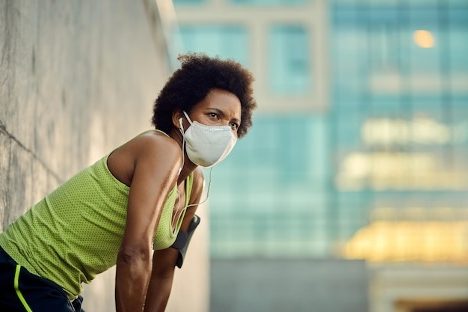In an era where health and safety have become paramount, the introduction of masks into our workout routines represents a significant adaptation.
With the global health landscape evolving, wearing a mask while exercising has sparked a mix of reactions and adaptations among fitness enthusiasts.
While it undeniably plays a crucial role in safeguarding public health, it also brings forth challenges that are worth considering for those committed to maintaining their fitness regimes.
This comprehensive exploration delves into the advantages and disadvantages of wearing masks during physical exertion, aiming to provide a balanced perspective for fitness aficionados navigating this new reality.
The upsides of masked workouts
Enhanced protection against airborne particles: The primary benefit of wearing a mask while exercising is the protection it offers against airborne contaminants, particularly in shared or indoor environments where the risk of airborne transmission is higher.
Promotion of public health and safety: Utilizing a mask during physical activities, especially in communal settings like gyms or fitness classes, is a testament to one’s commitment to communal health and the safety of fellow participants.
Potential respiratory benefits: Some suggest that training with a mask might simulate aspects of high-altitude training by providing a form of resistance to breathing. This notion, while intriguing, requires more scientific backing but points to potential benefits in lung capacity and endurance.
Increased mindfulness and focus: Wearing a mask can encourage exercisers to be more mindful of their breathing patterns, potentially leading to improved breathing techniques and focus during workouts.
Adaptability and resilience: Regularly working out with a mask can foster a sense of adaptability and resilience, as individuals learn to maintain their exercise routines under altered conditions.
Downsides of masked workouts
Breathing challenges: Masks can restrict airflow, making it harder to breathe, especially during high-intensity workouts. This can lead to discomfort and might impact overall workout performance.
Overheating and discomfort: Exercising with a mask can increase the sensation of heat, sweat, and discomfort on the face, which can be particularly distracting or unpleasant during longer or more intense exercise sessions.
Skin issues: The combination of sweat and prolonged mask-wearing can lead to skin irritations or acne, often referred to as “maskne.”
Sensory overload: For some, the sensation of the mask can be overwhelming, leading to increased discomfort or a feeling of claustrophobia, particularly during vigorous exercise.
Communication barrier: In group settings, masks can muffle speech, making it difficult to communicate with trainers or fellow gym-goers.
Balance the equation: Safety and Comfort in Masked Workouts
Select appropriate mask: Opt for masks made from breathable, moisture-wicking materials, designed specifically for physical activity. This choice can help mitigate some of the cons, such as overheating and skin irritation.
Be attuned to physical responses: It’s essential to be aware of how your body reacts to exercising with a mask. If you experience notable discomfort, dizziness, or breathing difficulties, it’s crucial to lower the intensity or take breaks.
Maintain mask hygiene: To prevent skin issues and maintain overall hygiene, use a clean mask for each workout session. Regularly washing reusable masks is vital in keeping them sanitary and effective.
Conclusion
The practice of wearing a mask during workouts presents a mix of benefits and challenges.
While it contributes significantly to public health efforts, it can also introduce physical and sensory challenges that need addressing.
The key is to find a balance that prioritizes safety without compromising the effectiveness and enjoyment of your workout.
By selecting the right type of mask, staying attuned to your body’s signals, and maintaining strict hygiene practices, you can navigate the complexities of masked workouts effectively, ensuring both health and fitness goals are met.


